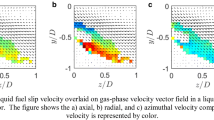Abstract
In aviation gas turbine combustors, many factors, such as the degree and extent of fuel/air mixing, and fuel vaporization achieved prior to combustion, influence the formation of pollutants. To assist in analyzing the extent of fuel/air mixing, flow visualization techniques have been used to interrogate the fuel distributions during subcomponent tests of lean-burning fuel injectors. Combustor pressures (up to 14 bar) and air inlet temperatures (up to 680K) were typical of actual gas turbine engine operating conditions. Discrimination between liquid and vapor phases of the fuel was accomplished by comparing planar laser-induced fluorescence (PLIF) images, elastically-scattered light images, and phase/Doppler interferometer measurements. Estimates of Sauter mean diameters are made by ratioing PLIF and Mie scattered intensities for various sprays, and factors affecting the accuracy of these estimates are discussed. Mie calculations of absorption coefficients indicate that the droplet fluorescence intensities are proportional to their surface areas, instead of their volumes, due to the high absorbance of the liquid fuel for the selected excitation wavelengths.
Similar content being viewed by others
References
Barber, P. W. and Hill, S. C., Light Scattering by Particles: Computational Methods, (1990), World Scientific Publishing Co., Singapore.
Bulzan, D. L., Structure of a Swirl-Stabilized Combusting Spray, J. Prop. Power, 11-6 (1995), 1093–1102.
Herpfer, D. C. and Jeng, S. M., Streaked Particle Image Velocimetry and Sizing in Burning and Non-Burning Sprays, 33rd Aerospace Sciences Meeting and Exhibit (Reno), (1995), AIAA Paper No. 95-0141.
Locke, R. J., Hicks, Y. R., Anderson, R. C. and Zaller, M. M., Optical Fuel Injector Patternation Measurements in Advanced Liquid-Fueled, High Pressure, Gas Turbine Combustors, Combust. Sci. Tech., 138 (1998), 297–311.
McDonell, V., Lee, S. and Samuelsen, S., Interpretation of Spray Behavior in Complex Aerodynamic Flows Using Phase Doppler Interferometry and Planar Liquid Laser Induced Fluorescence, Proc. SPIE, Optical Techniques in Fluid, Thermal, and Combustion Flow, 2546 (1995), 530–539.
Rotunno, A. A., Winter, M., Dobbs, G. M. and Melton, L. A., Direct Calibration Procedures for Exciplex-Based Vapor/Liquid Visualization of Fuel Sprays, Combust. Sci. and Tech., 71 (1990), 247–261.
Sankar, S. V., Maher, K. E., Robart, D. M. and Bachalo, W. D., Rapid Characterization of Fuel Atomizers Using an Optical Patternator.Proceedings of ASME Asia ’97 (Singapore), (1997).
Yeh, C. N., Kosaka, H. and Kamimoto, T., Measurement of Drop Sizes in Unsteady Dense Sprays, inRecent Advances in Spray Combustion: Spray Atomization and Drop Burning Phenomena, (1995), AIAA, Reston, VA, 297–308.
Author information
Authors and Affiliations
Additional information
Michelle Zaller: She received her B.S. and M.S. in Mechanical Engineering from Case Western Reserve University in Cleveland Ohio. She has been conducting combustion research at the NASA Lewis (now Glenn) Research Center since 1988, performing experimental investigations on optically-accessible rocket engines, as well as on numerous liquid-fueled air-breathing engine combustor configurations. Her primary interest has been application of optical diagnostics to subscale combustors, with special focus on studying the impact of critical phase transition effects on propellant mixing in high pressure propulsion systems.
Randy J. Locke: He earned his Ph.D. in Physical Chemistry at Wayne State University in Detroit Michigan where he studied intramolecular/intermolecular photoassociation processes. He was a National Academy of Science/National Research Council (NAS/NRC) Postdoctoral Associate, at the U. S. Army Research Laboratory (ARL), Aberdeen Proving Ground, MD. While at the ARL he performed optical studies on low pressure gaseous flames, laser-induced microplasma formation, and laser-induced ignition of solid propellants. For the past 9 years he has studied high pressure combustion processes for aerospace propulsion applications. His main research interests are to gain a detailed understanding of the physical processes inherent in reacting, high pressure flows via advanced laser diagnostic techniques. He is the author of 12 open literature papers and 30 technical reports and government publications.
Robert C. Anderson: He received his Bachelor of Engineering Science (Physics) degree at Cleveland State University in 1966 and his Masters in Engineering Science from the University of Toledo in 1971. He has worked on the development of advanced instrumentation systems throughout his career at the NASA Glenn Research Center, in Cleveland Ohio. Technical areas of interest have included dynamic pressure measurement, smoke measurement, gas analyzer systems, and currently advanced laser diagnostics for combustion research.
Rights and permissions
About this article
Cite this article
Zaller, M., Locke, R.J. & Anderson, R.C. Comparison of techniques for non-intrusive fuel drop size measurements in a subscale gas turbine combustor. J Vis 2, 301–308 (2000). https://doi.org/10.1007/BF03181446
Received:
Revised:
Issue Date:
DOI: https://doi.org/10.1007/BF03181446




